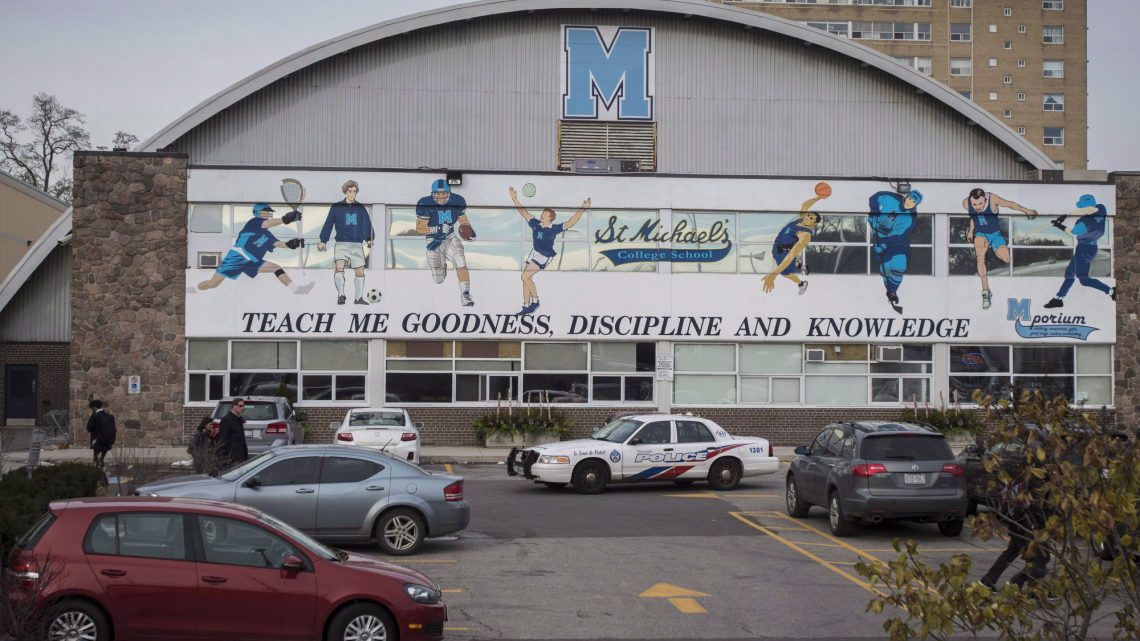
How Hazing Escalates to Sexual Assault
November 28, 2018This article originally appeared on VICE Canada.
There’s a lot we don’t know about the scandal erupting at St. Michael’s College School in Toronto, but the allegations we’ve heard so far are horrifying.
Six students from the all-boys private Catholic school have each been charged with gang sexual assault, sexual assault with a weapon, and assault after a video surfaced showing a student allegedly being sexually assaulted with a broomstick.
In total, Toronto police are investigating six separate incidents tied to the school, two sexual assaults, two assaults, assault with a weapon, and making threats. There are at least four videos being investigated, with at least one victim per video, police said. Eight students have been expelled.
The only charges that have been laid relate to the broomstick sexual assault. The video of that alleged attack reportedly shows a student naked from the waist down and being sexually assaulted with a broomstick in the school’s locker room, as fellow students hold his legs down. Another video allegedly shows a boy in a washroom sink in his underwear with water being run over him, as other students slap his bare skin—the events in that video are being investigated as assault
In light of the scandal, the school, which serves Grades seven through 12, has canceled all “events involving external groups, teams, and public performances” for the rest of 2018 and canceled the rest of the junior football season. The principal and president have both resigned.
The incidents, described by some students to reporters as hazing, have brought up a host of conversations around hazing and toxic masculinity. Recently, former NHL player Daniel Carcillo revealed he was brutally hazed while he was a 17-year-old rookie for the Sarnia Sting of the OHL.
Carcillo told the Canadian Press he was subjected to daily beatings with a sawed off hockey stick, and that rookies were urinated on in the shower by other teammates. St. Mike’s alumnus Jean-Paul Bedard told CityNews he experienced “sexualized violence” as part of a hazing rite when he played on the school’s football team in the 80s.
It’s hard to quantify how common sexual hazing incidents are, but anecdotally, we’ve all seen the stories. Just this week, four students at a school in Damascus, Maryland were released on bond after being charged with first-degree rape for allegedly raping a fellow member of their football team with a broomstick. A similar incident involving high school football players sexually assaulting a freshman with a broomstick took place in Oklahoma City at the end of September.
Even the controversial Netflix show 13 Reasons Why, about the suicide of a teenage girl, depicted a sexual assault with a broomstick in an episode of the second season, where several jocks ganged up on a social outcast.
Norm Pollard, dean of students at Alfred University in New York, told VICE he believes part of the reason hazing goes to such an extreme level is because the perpetrators were victimized themselves.
“There’s typically a cycle of violence that occurs,” said Pollard, who wrote the chapter on sexual hazing in Hank Nuwer’s book Hazing: Destroying Young Lives. “Sometimes they ratchet it up a notch, make it a little bit more humiliating, a little more perverted, in order to rationalize what was done to them.”
Pollard, who noted an incident can be classified as both sexual assault and hazing, said the sexual aspect of hazing is about domination and control.
“For adolescent males specifically, they’re very insecure about their identity, even more insecure about their sexuality and a… hyper masculine activity is to dominate and control someone who is subservient,” said Pollard. A mob mentality can also make it easier to dismiss the severity of the abuse, he said.
One of the things that makes hazing uniquely difficult for the victim is the fact that the perpetrator is often a teammate.
“There’s this really odd dynamic of ‘I really want to belong, I really want to be part of this team… and at the same time, you have to put up with this assault about something very personal, very private, and very scarring in order to prove your worthiness to be a member.”
Victor Schwartz, chief medical officer at The Jed Foundation, a New York-based non-profit geared at preventing youth suicide, echoed Pollard’s points about how hazing escalates when kids try to outdo each other. But he said TV shows are partially to blame.
He pointed to the fact that the creators of 13 Reasons Why defended the show’s content by saying it’s important to confront audiences with the realities of things like suicide and rape.
“It might scare and disturb many of them,” Schwartz told VICE. “That approach for people who might be at risk themselves of violent or suicidal behavior, that actually might be exciting and thrilling rather than disturbing.”
Schwartz pointed to shows like Jackass as an example of upping the ante in order to gain more shock value—that’s something that is mimicked in real life, and in hazing, he said.
Pollard said while it’s not true that all of these incidents were inspired by TV, “for some it gives them an idea for their ‘initiation.’” He said when Fear Factor was popular, there would be high school students forcing team members to eat disgusting things or engage in physically risky acts.
In part, this is why Pollard doesn’t believe there is such a thing as harmless hazing.
If no one intervenes over the silly stuff, “what they’ll do is more serious, more savage, more humiliating, sometimes more deadly, in private."
And that behavior can continue on long after high school, he said.
“This is an age where adolescents learn a lot about who they are and how they function, they take that lesson into other areas of their life, whether they’re starting junior hockey, or they go onto a fraternity, or they get in a relationship and this is how they exert power is through abuse and domination.”
—with files from Rob Csernyik
Sign up for our newsletter to get the best of VICE delivered to your inbox daily.
Follow Manisha Krishnan on Twitter.


